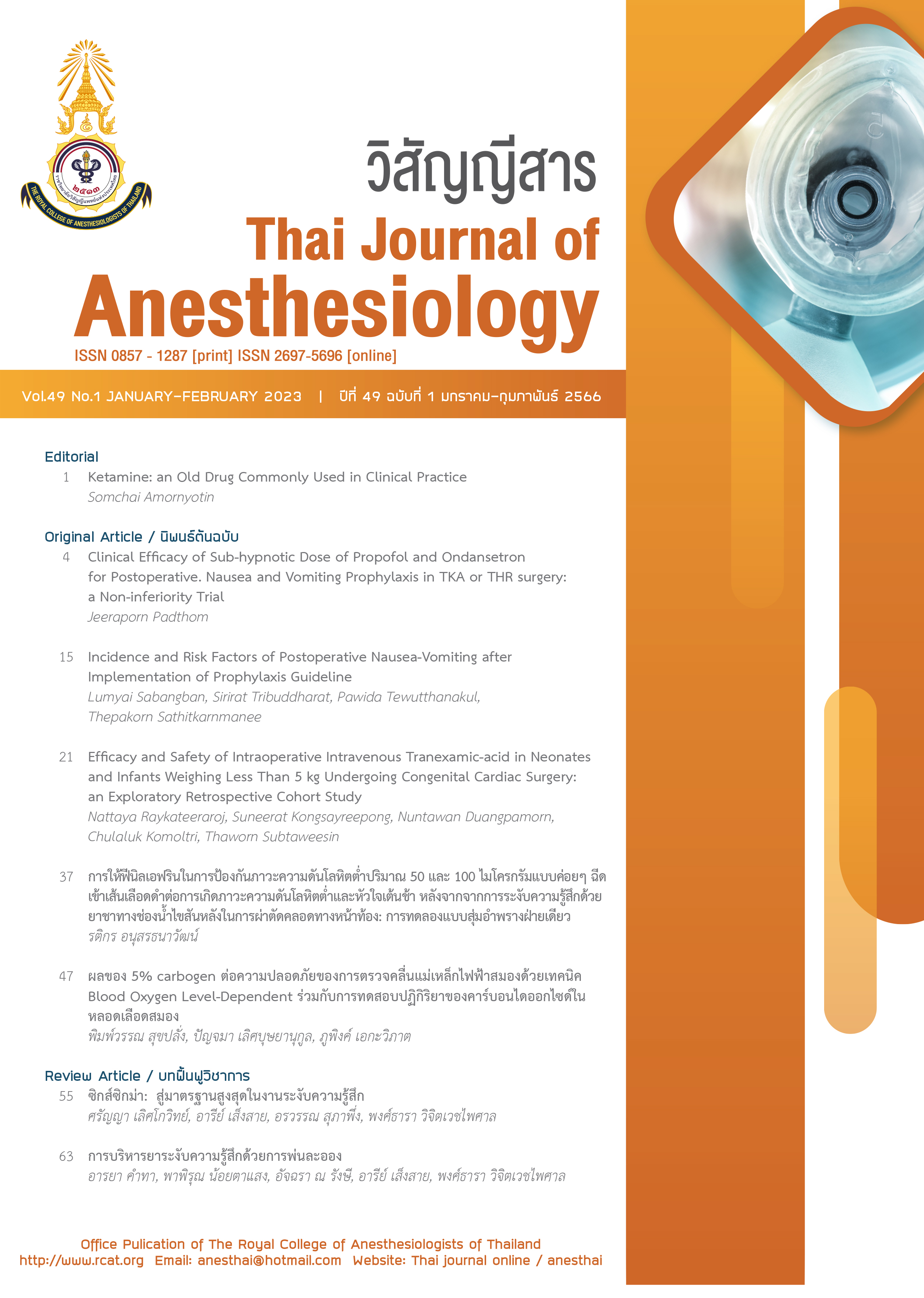Ketamine: an Old Drug Commonly Used in Clinical Practice
Main Article Content
Abstract
Ketamine, an old intravenous anesthetic, is a non-narcotic and non-barbiturate drug. It has been there in clinical anesthesia practice for more than sixty years. Importantly, it plays an invaluable role in the developing countries including Thailand. Ketamine mainly works by non-competitive antagonist at the N-methyl-D-aspartate (NMDA) receptors. It has several properties of the ideal anesthetic agent. Ketamine was formerly used as a sole agent for anesthesia, inducing analgesia, amnesia, loss of consciousness and immobility. Therefore, its properties are interesting in various clinical settings, although it can produce the psychological adverse effects.
Article Details

This work is licensed under a Creative Commons Attribution-NonCommercial-NoDerivatives 4.0 International License.
References
Amornyotin S. Ketamine: pharmacology revisited. Int J Anesthesiol Res. 2014;2:42-4.
Mion G, Villevieille T. Ketamine pharmacology: an update (pharmacodynamics and molecular aspects, recent findings). CNS Neurosci Ther. 2013;19:370-80.
Jolly AS, Jain P, Sood J. Ketamine-current uses and future perspectives. J Anaesthesiol Clin Pharmacol. 2007;23:169-81.
Ostermann ME, Keenan SP, Seiferling RA, Sibbald WJ. Sedation in the intensive care unit: a systematic review. JAMA. 2000;283:1451-9.
Choe H, Choi YS, Kim YH, et al. Epidural morphine plus ketamine for upper abdominal surgery improved analgesia from preincisional versus postincisional administration. Anesth Analg. 1997;84:560-3.
Miller AC, Jamin CT, Elamin EM. Continuous intravenous infusion of ketamine for maintenance sedation. Minerva Anestesiol. 2011;77;812-20.
Braun P, Wenzel V, Paal P. Anesthesia in prehospital emergencies and in the emergency department. Curr Opin Anesthesiol. 2010;23:500-6.
Bell RF. Ketamine for chronic noncancer pain. Pain. 2009;141:210-4.
Good P, Tullio F, Jackson K, Goodchild C, Ashby M. Prospective audit of short-term concurrent ketamine, opioid and anti-inflammatory “triple-agent” therapy for episodes of acute on chronic pain. Intern Med J. 2005;35:39-44.
Kose EA, Dal D, Akinci SB, Saricaoglu F, Aypar U. The efficacy of ketamine for the treatment of postoperative shivering. Anesth Analg. 2008;106:120-2.
Amornyotin S. Ketofol: a combination of ketamine and propofol. J Anesth Crit Care Open Access. 2014;1: 00031.
Amornyotin S. Sedative and analgesic drugs for gastrointestinal endoscopic procedure. J Gastroenterol Hepatol Res. 2014;3:1133-44.
Amornyotin S. Use of a combination of ketamine and dexmedetomidine (Ketodex) in different clinical cases. J Addict Med Ther Sci. 2020;6:041-4.
Amornyotin S, Kongphlay S. Clinical efficacy of combination of propofol and ketamine (ketofol) for deep sedation in colonoscopic procedure. J Gastroenterol Hepatol Res. 2015;4:1689-93.


